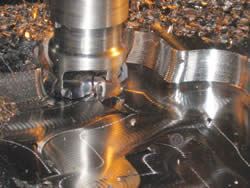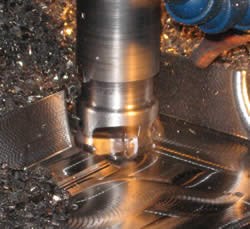Cutting Tool Slashes Cycle Times by 75 Percent
This moldmaker reduces cycle times from 10 hours to two hours with a more durable, faster cutter that also leaves a nice finish.
Specializing in milling and EDM’ing large, complex 3-D geometry for various tool steels for both molds and foundry patterns, Lawrenceburg, IN-based Ohio Valley Precision, Inc. (OVP) was looking to reduce its cycle times, according to President Scott Allen. The addition of Sumitomo Electric Carbide, Inc.’s (Mount Prospect, IL) Metal Slash Mill allowed him to reduce a 10-hour cycle time to two hours.
Allen established this 11-employee shop in 2006, and now that times are especially challenging in the industry, he wanted to improve customer delivery times even more. “Back then, when the economy was good, we had plenty of time to get a casting and machine a casting,” Allen recalls. “Today, you have to figure out the fastest, least expensive way to cut away this material. What used to be 10 weeks to build a tool has now turned into four weeks or less. So, you have to go back the drawing board and ask yourself, ‘What can I do to produce this tool in a short amount of time?’ That is where Sumitomo plays a big factor.”
Making the Cut
Allen and OVP Senior Engineer David Ray discovered that the Sumitomo Metal Slash Mill worked the best with its Makino machines. “The advantage of our machines is that they are strong, rigid and fast,” Allen explains. “The Sumitomo cutters hold up to our machines’ capabilities and complement them. Ten years ago, we would take carbide tools and run them 75 inches a minute roughing stock off. Today, with the Sumitomo cutters we are roughing 175 to 185 inches a minute. If we have a mold that is 48 x 44 inches and 8 inches tall, you have gone from three days of roughing to one day.”
“We’ve also found with this tooling that you may not be taking as big of depth of cut, but since you are cutting three times as fast, it’s easier on the machines and you can remove the material a lot quicker,” Allen continues. “This is huge. The Sumitomo is faster, the tools hold up, and the carbide itself for the inserts costs less. It’s a homerun for what we are doing.”
Although these tools are primarily for roughing, Allen points out that these tools also can be used for finishing. “We used to have to run through four or five carbide end mills to finish cut something,” Allen notes, “but now we are using one insert to cut the whole thing. And that one insert is 25 dollars, whereas before it was 150 dollars worth of carbide to finish one impression. We are absolutely amazed every time we pull a part out of the machine at the accuracy and finish that is there.”
Allen also points out that it is not necessary to have an operator standing at the machine to watch the cutter operate. “We do have to be in the building, but we can hit the green button and walk away to start up another machine, and have enough confidence in the tools that they are going to hold up while we are roughing it out,” he notes.
A Slice of Moldmaking Pie
According to Allen, the right combination of the Sumitomo cutter with higher end machining equipment also has allowed OVP to diversify. “We are doing complex parts for the steel industry as well as branching out into aerospace,” he states. “We also are able to deliver our tools early. If you are able to deliver the tool early or on time, you have a tendency to get what you are quoting for the tool.”
Allen is extremely happy with the success of the Sumitomo cutter, but also is quick to acknowledge the employees behind the technology. “You can have all of the latest, greatest equipment in the world, but if you don’t have the right core of people under your roof, it all goes by the wayside,” he states. “It’s the people who produce the product the right way and get the job out on time.”
Related Content
Forces and Calculations Are Key to Sizing Core Pull Hydraulic Cylinders
To select the correct cylinder, consider both set and pull stroke positions and then calculate forces.
Read More6 Ways to Optimize High-Feed Milling
High-feed milling can significantly outweigh potential reliability challenges. Consider these six strategies in order to make high-feed milling successful for your business.
Read MoreAdvantages and Disadvantages of Copper and Graphite Electrodes
Both copper and graphite provide approximately the same end result, so it is important for a shop to consider the advantages and disadvantages of each material in order to discover what would work best in their shop floor environment.
Read MoreLaser Welding Versus Micro Welding
The latest battle in finely detailed restoration/repair of mold materials.
Read MoreRead Next
Determining the Value Of Your Cutting Tool
How to reach the break even point of your cutting tool investment within hours.
Read MoreAre You a Moldmaker Considering 3D Printing? Consider the 3D Printing Workshop at NPE2024
Presentations will cover 3D printing for mold tooling, material innovation, product development, bridge production and full-scale, high-volume additive manufacturing.
Read MoreHow to Use Strategic Planning Tools, Data to Manage the Human Side of Business
Q&A with Marion Wells, MMT EAB member and founder of Human Asset Management.
Read More










.png;maxWidth=300;quality=90)








_300x250 3.png;maxWidth=300;quality=90)
.jpg;maxWidth=300;quality=90)







